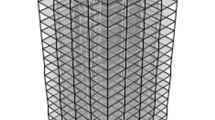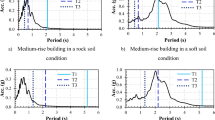Abstract
The extended N2 method has been developed, which takes into account higher mode effects both in plan and in elevation. The extension is based on the assumption that the structure remains in the elastic range when vibrating in higher modes. The seismic demand in terms of displacements and storey drift can be obtained by combining the results of basic pushover analysis and those of standard elastic modal analysis. In the paper, the proposed procedure was summarized and applied to a test example which represents an actual 8-storey reinforced concrete building. The results obtained by the extended N2 method were compared with the results of nonlinear response history analysis and basic N2 analysis without the consideration of higher modes. The extended N2 method was able to provide fair, conservative estimates of response in the case of the test example. In comparison to the basic N2 method, the prediction of seismic demand was greatly improved in the upper part of the building and at the flexible edges.
Similar content being viewed by others
References
Antoniou S, Pinho R (2004) Development and verification of a displacement-based adaptive pushover procedure. J Earthq Eng 8(5): 643–661
Aydınoğlu MN (2003) An incremental response spectrum analysis procedure based on inelastic spectral displacements for multi-mode seismic performance evaluation. Bull Earthq Eng 1(1): 3–36
Aydınoğlu MN (2004) An improved pushover procedure for engineering practice: incremental response spectrum analysis (IRSA). In: International workshop on “performance-based seismic design: concepts and implementation”, Bled, Slovenia, PEER report 2004/05, pp 345–356
Aydınoğlu MN, Önem G (2010) Evaluation of analysis procedures for seismic assessment and retrofit design. In: Garevski M, Ansal A (eds) Earthquake engineering in Europe, Geotechnical, Geological, and Earthquake Engineering, vol 17. Springer, Dordrecht
Baros DK, Anagnastopoulos SA (2008) An assessment of static nonlinear pushover analyses in 2-D and 3-D applications, In: Bento R, Pinho R (eds) 3D Pushover 2008—proceedings of nonlinear static methods for design/assessment of 3D structures. IST Press, Lisbon, pp 45–58
Bento, R, Pinho, R (eds) (2008) 3D Pushover 2008 proceedings of nonlinear static methods for design/assessment of 3D structures. IST Press, Lisbon, Portugal
Bento R, Bhatt C, Pinho R (2010) Using nonlinear static procedures for seismic assessment of the 3D irregular SPEAR building. Earthq Struct 1(2): 177–195
Bhatt C, Bento R (2011) Assessing the torsional response of existing RC building using the extended N2 method. Bull Earthq Eng. doi:10.1007/s10518-011-9252-8
Čaušević M, Mitrović S (2010) Comparison between non-linear dynamic and static seismic analysis of structures according to European and US provisions. Bull Earthq Eng. doi:10.1007/s10518-010-9199-1
CEN (2004) Eurocode 8—design of structures for earthquake resistance. Part 1: general rules, seismic actions and rules for buildings. European standard EN 1998-1, December 2004, European Committee for Standardization, Brussels
CEN (2005) Eurocode 8—design of structures for earthquake resistance. Part 3: assessment and retrofitting of buildings. European standard EN 1998-3. June 2005. European Committee for Standardization, Brussels
Chopra AK (2007) Dynamics of structures—theory and applications to earthquake engineering, 3rd edn. Prentice Hall, New Jersey, Section 19.7.3.
Chopra AK, Goel RK (2002) A modal pushover analysis procedure for estimating seismic demands for buildings. Earthq Eng Struct Dyn 31(3): 561–582
Chopra AK, Goel RK (2004) A modal pushover procedure to estimate seismic demands for unsymmetric-plan buildings. Earthq Eng Struct Dyn 33(8): 903–927
Chopra AK, Goel RK, Chintanapakdee C (2004) Evaluation of a modified MPA procedure assuming higher modes as elastic to estimate seismic demands. Earthq Spectra 20(3): 757–778
CSI: (2006) PERFORM 3D nonlinear analysis and performance assessment for 3D structures. Computers & Structures Inc, Berkeley
De Stefano M, Pintucchi B (2010) Predicting torsion-induced lateral displacements for pushover analysis: influence of torsional system characteristics. Earthq Eng Struct Dyn 39(12): 1369–1394
Elnashai AS (2001) Advanced inelastic static (pushover) analysis for earthquake applications. Struct Eng Mech 12(1): 51–69
Erduran E (2008) Assessment of current nonlinear static procedure on the estimation of torsional effects in low-rise frame buildings. Eng Struct 30(9): 2548–2558
Erduran E, Ryan KL (2010) Effects of torsion on the behavior of peripheral steel-braced frame systems. Earthq Eng Struct Dyn 40(5): 491–507
Fajfar P (1999) Capacity spectrum method based on inelastic demand spectra. Earthq Eng Struct Dyn 28(9): 979–993
Fajfar P (2000) A nonlinear analysis method for performance-based seismic design. Earthq Spectra 16(3): 573–592
Fajfar P, Marušić D, Peruš I (2005) Torsional effects in the pushover-based seismic analysis of buildings. J Earthq Eng 9(6): 831–854
FEMA (2009) Quantification of building seismic performance factors. FEMA—P695 report Federal emergency management agency, Washington, DC
Fujii K (2011) Nonlinear static procedure for multi-story asymmetric frame buildings considering bi-directional excitation. J Earthq Eng 15(2): 245–273
Goel RK, Chopra AK (2005) Extension of modal pushover analysis to compute member forces. Earthq Spectra 21(1): 125–139
Kalkan E, Kunnath SK (2006) Adaptive modal combination procedure for nonlinear static analysis of building structures. J Struct Eng (ASCE) 132(1): 1721–1731
Kalkan E, Kunnath SK (2007) Assessment of current nonlinear static procedures for seismic evaluation of buildings. Eng Struct 29(3): 305–316
Krawinkler H (2006) Importance of good nonlinear analysis. Struct Des Tall Spec Build 15(5): 515–531
Krawinkler H, Seneviratna GDPK (1998) Pros and cons of a pushover analysis for seismic performance evaluation. Eng Struct 20(4–6): 452–464
Kreslin M, Fajfar P (2011) The extended N2 method taking into account higher mode effects in elevation. Earthq Eng Struct Dyn. doi:10.1002/eqe.1104
Lin JL, Tsai KC (2008) Seismic analysis of two-way asymmetric building systems under bi-directional seismic ground motions. Earthq Eng Struct Dyn 37(2): 305–328
Marušić D, Fajfar P (2005) On the inelastic seismic response of asymmetric buildings under bi-axial excitation. Earthq Eng Struct Dyn 34(8): 943–963
Moghadam AS, Tso WK (2002) A pushover procedure for tall buildings. In: Proceedings of the 12th European conference on earthquake engineering, London, UK, Paper 395
PEER (2006) PEER NGA Database. Pacific Earthquake Engineering Research Center, University of California, Berkeley, available at http://peer.berkeley.edu/nga/
Peruš I, Fajfar P (2005) On the inelastic torsional response of single-storey structures under bi-axial excitation. Earthq Eng Struct Dyn 34(8): 931–941
Poursha M, Khoshnoudian F, Moghadam AS (2009) A consecutive modal pushover procedure for estimating the seismic demands of tall buildings. Eng Struct 32(2): 591–599
Reyes JC, Chopra AK (2010) Three-dimensional modal pushover analysis of buildings subjected to two components of ground motion, including its evaluation for tall buildings. Earthq Eng Struct Dyn. doi:10.1002/eqe.1060
Reyes JC, Chopra AK (2011) Evaluation of three-dimensional modal pushover analysis for unsymmetric-plan buildings subjected to two components of ground motion. Earthq Eng Struct Dyn. doi:10.1002/eqe.1100
Sucuoğlu H, Günay MS (2010) Generalized force vectors for multi-mode pushover analysis. Earthq Eng Struct Dyn. doi:10.1002/eqe.1020
Author information
Authors and Affiliations
Corresponding author
Rights and permissions
About this article
Cite this article
Kreslin, M., Fajfar, P. The extended N2 method considering higher mode effects in both plan and elevation. Bull Earthquake Eng 10, 695–715 (2012). https://doi.org/10.1007/s10518-011-9319-6
Received:
Accepted:
Published:
Issue Date:
DOI: https://doi.org/10.1007/s10518-011-9319-6




